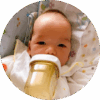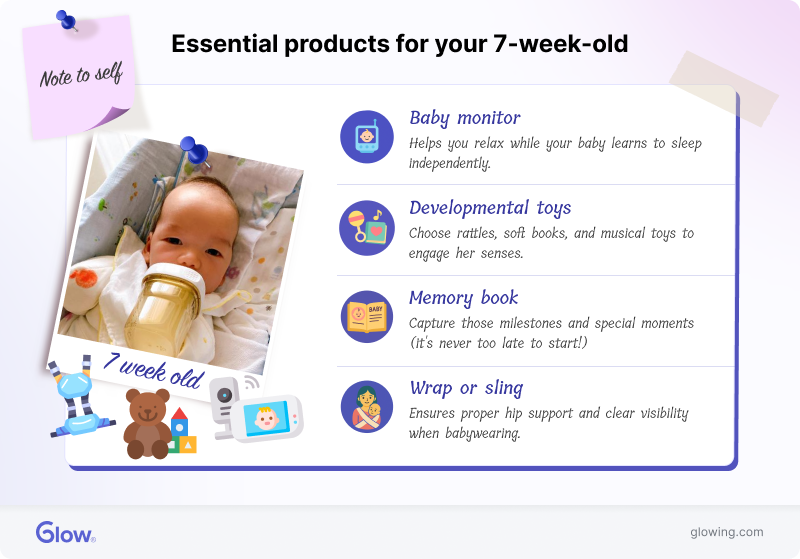Baby Month by Month
7-Week-Old Baby
Your baby may have learned to look for familiar faces (including yours!)

By now, you’re probably recognizing more of your baby’s personal cues and rhythms. She’s engaging more with the world, developing more physical skills, and (hopefully for you) sleeping more during the night. Read on to find out what to expect from your 7-week-old and how to help her development.
Your baby’s developments and milestones at 7 weeks
At 7 weeks, your baby is growing quickly and might have reached these developmental milestones:
- Increased awareness: She can now track movements with her eyes, turn her head toward sounds, and show a preference for familiar faces (like yours!)
- Social smiles: You may have already seen a few of your baby’s gummy smiles, which will become more frequent at 7 weeks. Smiles at this stage aren’t just random reflexes; they’re reactions to your voice, face, or interactions. 1
- Emerging communication: You may notice more varied vocalizations from your 7-week-old. She might even have distinct cries for her different needs, like food, sleep, or a diaper change.
- Muscular control: Your baby’s neck muscles are getting stronger every day. As a result, she can lift her head for longer periods during tummy time.
How much weight should your baby gain?
Babies typically gain around 1 ounce per day after the second week of their birth. 2 That said, all babies grow at their own speed, so don’t get too fixated on the numbers. Yours is on the right track as long as your pediatrician says she’s healthy.
How to keep your baby healthy at 7 weeks
Your little one’s day still revolves mostly around sleeping and eating. Consequently, yours probably does, too!
Here’s what to expect from a 7-week-old’s sleeping and feeding patterns, as well as common health concerns you should look out for.
Sleep patterns
Your baby is still probably sleeping around 10–18 hours a day and is only active for 1 to 3 hours at a time (also called a wake window). While it may seem like your baby is sleeping too much, this is normal. Note that a good portion of this sleep will be overnight at this point. 3
That said, while she’s sleeping for longer stretches, she won’t sleep through the night until she’s 4 to 6 months old. She’ll still wake up for nighttime feedings and diaper changes. 4
You can help your baby sleep better by putting her to bed when you notice signs of drowsiness, such as yawning, rubbing her eyes, looking away, and fussing. Try dimming the lights, using blackout curtains, and using a white noise machine to set the right ambience for bedtime. 5
This is a great time to establish a bedtime routine for your baby. For instance, you can sing lullabies or play calm music to her as she gets sleepy. Many experts recommend putting her in bed while she’s sleepy but still awake so that she can learn how to put herself to sleep. 5
Feeding patterns
Your baby probably just went through one of her growth spurts at 6 weeks old (which explains why she was feeding so often, which is known as cluster feeding). Hopefully she’s now settling into a more predictable eating pattern. 6
Keep feeding your baby on demand (i.e., whenever she’s hungry); pay close attention to her cues. 7 Right now, you need to give her about 7–8 feedings a day and 2–4 ounces every 2–4 hours. 8
Keep an eye out for signs of fullness to avoid overfeeding, which can make your baby gassy or cause diarrhea and spit-up. 9 These signs include turning her head away, pausing frequently, or falling asleep during feeding.
You can track her feeding habits by keeping a log in your journal or a baby tracker app. The best baby trackers also let you view this info in charts for easy reference.
Common health concerns
Your baby is hopefully thriving at this stage, but you should still be aware of these health issues:
- Positional plagiocephaly: Commonly known as flattened head syndrome, this is when your baby’s head has a flat or bald spot due to always sleeping in the same position. These flat spots usually aren’t dangerous, although in severe cases, they can cause issues later in life, such as facial asymmetry, problems with neck control, jaw misalignment, and chewing and speech issues. You can prevent this by encouraging more tummy time and changing your baby’s head position when she sleeps, although be sure to ask your pediatrician for the safe way of doing this. 10
- Torticollis: This describes a tightening of the neck muscles, which causes the head to tilt to one side. If your baby has torticollis, you may notice she keeps looking in the same direction, and you might feel a “knot” the size of a pea on her neck. Your pediatrician will probably recommend gently massaging and stretching her neck. 11
Call your doctor if you suspect your baby has positional plagiocephaly or torticollis. They’ll help you assess her condition and tell you how to address it (if they decide that it needs fixing at all).
Other symptoms to watch out for
You should call your pediatrician if your baby has:
- A fever of 100.4°F (38°C) or higher
- Signs of dehydration like decreased wet diapers, dry mouth, sunken fontanelles (soft spots on your baby’s head) 12
- Persistent vomiting or diarrhea
- Excessive fussiness or lack of energy
- Difficulty breathing
- Rash or discharge you haven’t seen up to this point
Your baby will be getting a series of vaccinations soon
Your baby’s 2-month check-up is right around the corner, and she’ll be getting vaccinations that’ll protect her from serious illnesses. According to the CDC’s vaccine schedule, she’ll be getting her first dose of the rotavirus, DTaP, Hib, pneumococcal, and polio vaccines, and her second dose of the Hepatitis B vaccine (if she hasn’t gotten it already).
Tips for taking care of a 7-week-old baby
This is an exciting time as your baby grows more alert and attentive to her surroundings. You can help her development by engaging her senses with:
Visual stimulation
Slowly move a colorful toy or rattle from side to side to let your baby’s eyes track the object and develop her eye-muscle control.
Her eyes will be able to discern more complex designs and different colors as she grows. Show her board books with vibrant colors to stimulate her vision. You can also hold a baby-safe mirror in front of her so she can see her own reflection.
Sunlight and your baby
Your baby’s skin is still very sensitive at 7 weeks, and you should keep her out of direct sunlight (especially from 10 a.m. to 2 p.m.). When you take her out in the sun, such as for a stroll in the park, use a hat, stroller shade, or lightweight clothing to protect her skin.
Don’t drape blankets over the stroller, as this can trap heat and make the temperature in the stroller dangerously hot. If your baby is often overheating in the sun, you may need to experiment with different options. The best baby strollers have breathable materials and large canopies to prevent this issue.
Note that you generally shouldn’t apply sunscreen to babies under 6 months old, which can cause them to develop skin problems, such as rashes. If you must apply sunshine on your baby for some reason, ask your pediatrician for advice beforehand. 13
Auditory stimulation
Your baby loves hearing your voice; she’s familiar with it from long before she’s born and finds it calming. Talk to her as much as you can. You can read her a children’s book or simply narrate your day to her. If she makes sounds, repeat them and add words to them (e.g., if she says “ba,” turn that into “ball”). 14
Singing to her and playing music in the background is also a great idea. This may improve her brain and emotional development—as well as hopefully kickstarting a lifelong love of music. 15
Tactile stimulation
Change your baby’s position often. Don’t put her in swings or bouncy seats for long periods of time; this can hinder her muscle development.
Give your baby gentle massages. This is a great way to bond with her while enhancing her sensory awareness. Keep giving her tummy time sessions to strengthen her neck, back, and shoulder muscles. When you do, you can get down to her eye level and sing or talk to her.

Essential products for your 7-week-old
Here are some products that’ll come in handy as your baby enters her seventh week:
- Baby monitor: Using a baby monitor will give you peace of mind, especially when you’re letting your baby learn how to sleep on her own and aren’t in the room with her every second that she’s napping.
- Baby mobile: Hanging a baby mobile above your baby’s crib or changing area gives her visual stimulation and can help soothe her.
- Developmental toys: Look for toys that will stimulate your baby’s senses. For example, you can buy different rattles, soft books, and musical toys.
- Wrap or sling (for babywearing): When choosing a carrier for your baby, make sure it supports her hips, allows her to breathe comfortably (doesn’t push her chin into her chest), and keeps her face visible. Keep your baby facing you while you carry her until she’s about 4 months old, as she won’t be able to support her head on her own until then.
- Baby memory book: This is more for you than for her. It’s not too late to get a baby memory book to document your baby’s key milestones and special moments now. You can also jot down your feelings during this time on the side.
- Newborn body care: Around 7 weeks, many parents start refining their baby care routine. Products like gentle baby shampoos, mild soap, baby-friendly moisturizers, and soft-bristled brushes will also come in handy—especially if your baby is dealing with a flaky scalp (cradle cap) or baby acne, both of which are common in the first year of life.
Tips for your own well-being
As you take care of your baby, don’t forget to prioritize your own well-being. Here are some tips for new moms:
- Physical activity: Find time to do some exercise, even if it’s just a short walk around the neighborhood. You’ll be in an even better mood and will feel more energetic.
- Support system: Lean on your support system, such as your family, friends, or parenting groups, for help and emotional support.
- Birth control: You can get pregnant just 4 weeks after giving birth. 16 However, most doctors recommend waiting for at least 6 weeks to have sex after childbirth (regardless of whether you gave birth naturally or you’re planning to have sex after a C-section). That means it’s back on the table at this point. If having another baby so soon isn’t in your plan, be sure to use birth control if and when you have sex.
- Communicate with your partner: If you’re raising your child with a partner, take the time to check in with each other and talk through the changes you’re both going through as parents.
Your mental health is just as important. Talk to your doctor if you have been struggling with persistent sadness (postpartum depression) or extreme anger (postpartum rage) after having your baby. They can guide you through your treatment options.
Final thoughts
Taking care of a 7-week-old is exciting (and more than a little draining, too!) As your baby starts interacting with you more, you’ll both get to know each other even better. Embrace these precious moments during the early weeks of motherhood, and don’t hesitate to reach out for help if you need it. Keep up the great work!
Article Sources
- Chicago Department of Public Health. "Talking, Singing, Reading, & Playing" Retrieved July 16, 2025.
- University of Rochester Medical Center. "The Growing Child: Newborn" Retrieved July 16, 2025.
- MedlinePlus. "Bedtime habits for infants and children" Retrieved July 16, 2025.
- Washington State Department of Health. "Healthy Sleep for Babies" Retrieved July 16, 2025.
- The Children's Hospital of Philadelphia. "Newborn-Sleep Patterns" Retrieved July 16, 2025.
- WIC Breastfeeding Support. "Cluster Feeding and Growth Spurts" Retrieved July 16, 2025.
- USDA Food and Nutrition Service. "Feeding Infants and Meal Pattern Requirements in CACFP - Q&As" Retrieved July 16, 2025.
- UC Davis Medical Center. "The First 12 Months: What & When to Feed Your Baby" Retrieved July 16, 2025.
- Human Lactation Center. "Baby Behavior: Tools for Medical Professionals" Retrieved July 16, 2025.
- The Children's Hospital of Philadelphia. "Managing Positional Plagiocephaly (Flat Head)" Retrieved July 16, 2025.
- UPMC Children’s Hospital. "Torticollis" Retrieved July 16, 2025.
- MedlinePlus. "Fontanelles - sunken" Retrieved July 16, 2025.
- U.S. Food & Drug Administration. "Should You Put Sunscreen on Infants? Not Usually" Retrieved July 16, 2025.
- U.S. Centers for Disease Control and Prevention. "Positive Parenting Tips: Infants (0–1 years)" Retrieved July 16, 2025.
- Head Start. "Music in Child Development" Retrieved July 16, 2025.
- Chicago Department of Public Health. "Family Planning After Giving Birth" Retrieved July 16, 2025.






